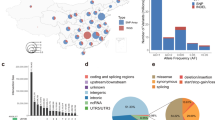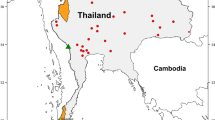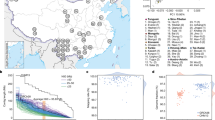Abstract
The Han Chinese is the largest single ethnic group in the world, consisting of ten Chinese branches. With the exception of the Pinghua branch, the genetic structure of this group has been studied extensively, and Y chromosome and mitochondrial (mt)DNA data have demonstrated a coherent genetic structure of all Han Chinese. It is therefore believed that the Pinghua branch, being members of an old branch of the Han Chinese, despite being scattered in and around Guangxi Province where members of the Daic and Hmong-Mien are more prevalent than Han Chinese, is no exception. We have studied 470 individual samples (including 195 males) from Pinghua populations and other ethnic groups (Zhuang, Kam, Mulam, Laka, and Mien) from six areas (Hezhou, Fuchuan, Luocheng, Jinxiu, Sanjiang, and Wuxuan) in the north of the Guangxi Zhuang Autonomous Region of China. Both mtDNA and the Y chromosomes were typed in these samples. High frequencies of the Y chromosome haplogroups O2a* and O*, which always present at a high frequency among the populations of the southern minorities, were found in Pinghua populations. Only Pinghua populations in Luocheng and Jinxiu maintain the Han frequent haplogroup O3a5a. mtDNA lineages B4a, B5a, M*, F1a, M7b1, and N* were found in Pinghua populations, exhibiting a pattern similar to the neighboring indigenous populations, especially the Daic populations. Cluster analyses (dendrograms, principal component analyses, and networks) of Pinghua populations, the other Han branches, and other ethnic groups in East Asia indicated that Pinghua populations are much closer to the southern minorities than to the other Han branches. Admixture analyses confirmed this result. In conclusion, we argue that Pinghua populations did not descend from Han Chinese, but from southern minorities. The ancestral populations of Pinghua people were assimilated by the Han Chinese in terms of language, culture, and self-identification and, consequently, the Pinghua people became an exceptional branch of Han Chinese’s coherent genetic structure.
Similar content being viewed by others
Log in or create a free account to read this content
Gain free access to this article, as well as selected content from this journal and more on nature.com
or
Reference
Bandelt HJ, Forster P, Rohl A (1999) Median-joining networks for inferring intraspecific phylogenies. Mol Biol Evol 16:37–48
Chen J, Li H, Qin ZD, Liu WH, Lin WX, Yin RX, Jin L, Pan SL (2006) Y-chromosome genotyping and genetic structure of Zhuang populations. Acta Genet Sin 33:1060–1072
Dupanloup I, Bertorelle G (2001) Inferring admixture proportions from molecular data: extension to any number or parental populations. Mol Biol Evol 18:672–675
Feng H (2007) General history of Yao Nationality (Yaozu Tongshi). Minzu Press, Beijing
Ge JX, Wu SD, Cao SD (1997) The migration history of China. Fujian People’s Press, Fuzhou
Hill C, Soares P, Mormina M, Macaulay V, Clarke D, Blumbach PB, Vizuete-Forster M, Forster P, Bulbeck D, Oppenheimer S, Richards M (2007) A mitochondrial stratigraphy for island southeast Asia. Am J Hum Genet 80:29–43
Kivisild T, Tolk HV, Parik J, Wang Y, Papiha SS, Bandelt HJ, Villems R (2002) The emerging limbs and twigs of the East Asian mtDNA tree. Mol Biol Evol 19:1737–1751
Li H (2005) Genetic structure of Austro-Tai populations. PhD Dissertation of human biology, Fudan University, Shanghai
Li H (2007) Abscondence of Min-Yue Ethnic group revealed by molecular anthropology. J Guangxi Univ Nationalities (Phil Soc Sci) 29:42–47
Li H, Pan W, Wen B, Yang N, Jin J, Jin L, Lu D (2003) Origin of Hakka and Hakkanese: a genetics analysis. Acta Genet Sin 30:873–880
Li H, Cai XY, Winograd-Cort ER, Wen B, Cheng X, Qin ZD, Liu WH (2007) Mitochondrial DNA diversity and population differentiation in Southern East Asia. Am J Phys Anthropol 134:481–488
Li LJ (2000) The history of PingHua. Chin Lang Literat (Zhongguo Yuwen) 6:24–30
Pan WY (2002) Language contact and the formation of Southeast Chinese Dialects. In: Zou JY (ed) Proc Hong Kong Language Contact Round Table. City University of Hong Kong Press, Hong Kong
Shi H, Dong YL, Wen B, Xiao CJ, Peter A. Underhill, Shen PD, Chakraborty R, Jin L, Su B (2005) Y-chromosome evidence of Southern Origin of the East Asian-Specific Haplogroup O3-M122. Am J Hum Genet 77:408–419
Su B, Xiao C, Deka R, Seielstad MT, Kangwanpong D, Xiao J, Lu D, Underhill P, Cavalli-Sforza L, Chakraborty R, Jin L (2000) Y chromosome haplotypes reveal prehistorical migrations to the Himalayas. Hum Genet 107:582–590
Wang J (2003) Maximum-likelihood estimation of admixture proportions from genetic data. Genetics 164:747–765
Wen B, Li H, Lu D, Song X, Zhang F, He Y, Li F, Gao Y, Mao X, Zhang L, Qian J, Tan J, Jin J, Huang W, Deka R, Su B, Chakraborty R, Jin L (2004a) Genetic evidence supports demic diffusion of Han culture. Nature 431:302–305
Wen B, Li H, Gao S, Mao X, Gao Y, Li F, Zhang F, He Y, Dong Y, Zhang Y, Huang W, Jin J, Xiao C, Lu D, Chakraborty R, Su B, Deka R, Jin L (2004b) Genetic structure of Hmong-Mien speaking populations in East Asia as revealed by mtDNA lineages. Mol Biol Evol 22:725–733
Wen B, Xie XH, Gao S, Li H, Shi H, Song XF, Qian TZ, Xiao CJ, Jin JZ, Su B, Lu D, Chakraborty Ranajit, Jin L (2004c) Analyses of Genetic Structure of Tibeto-Burman populations reveals sex-biased admixture in Southern Tibeto-Burmans. Am J Hum Genet 74: 856–865
Xu JS (1992) The development history of the Han Nationality. Sichuan Ethnic Press, Chengdu
Xu JS (1999a) Formation and culture traits of PingHua Population. J Guangxi Univ Nationalities (Phil Soc Sci) 21:103–108
Xu JS (1999b) Formation and culture traits of PingHua Population (continuation). J Guangxi Univ Nationalities (Phil Soc Sci) 21:93–97
Yao YG, Kong QP, Bandelt HJ, Kivisild T, Zhang YP (2002) Phylogeographic differentiation of mitochondrial DNA in Han Chinese. Am J Hum Genet 70:635–651
Yuan SL, Huang NJ (2005) Alternations and the external reasons for their prosperity of Guangxi dominating languages (including Local Chinese Dialects and Putonghua). J Liuzhou Teach Coll 20:64–68
Zhan BH, Chui SH, Liu XZ, Yang W (2003) The issues about the adscription of GuangXi PingHua. Chin Lang Res (Yuwen Yanjiu) 3:47–52
Acknowledgments
We especially thank all of the donors of our samples. The sample collectors include Yunping Lei of Fudan University, Zhe Wei, Shuo Lian, and Lisha Wang of Guangxi Medical University. Weixiong Lin and Xiaoqiu Luo also took part in the DNA extraction work. Our research was supported by the National Social Science Fund projects of China (2004 No.05XMZ015) to JSX, the National Natural Science Foundation of China (No.39993420) and the Genographic Project of National Geography to LJ, and Guangxi Natrural Science Foundation (No.GSN0728160, GSY0542044) to SLP.
Author information
Authors and Affiliations
Consortia
Corresponding author
Additional information
Rui-Jing Gan and Shang-Ling Pan contributed equally to this work.
Website:
Y chromosome haplogroup nomenclature of International Society of Genetic Genealogy: http://www.isogg.org/tree/ISOGG_YDNATreeTrunk07.html
Electronic supplementary material
Below is the link to the electronic supplementary material.
Rights and permissions
About this article
Cite this article
Gan, RJ., Pan, SL., Mustavich, L.F. et al. Pinghua population as an exception of Han Chinese’s coherent genetic structure. J Hum Genet 53, 303–313 (2008). https://doi.org/10.1007/s10038-008-0250-x
Received:
Accepted:
Published:
Issue date:
DOI: https://doi.org/10.1007/s10038-008-0250-x
Keywords
This article is cited by
-
Differentiated adaptative genetic architecture and language-related demographical history in South China inferred from 619 genomes from 56 populations
BMC Biology (2024)
-
Analysis of maternal genetic structure of mitochondrial DNA control region from Tai-Kadai-speaking Buyei population in southwestern China
BMC Genomics (2024)
-
Y-chromosome diversity suggests southern origin and Paleolithic backwave migration of Austro-Asiatic speakers from eastern Asia to the Indian subcontinent
Scientific Reports (2015)
-
A genetic contribution from the Far East into Ashkenazi Jews via the ancient Silk Road
Scientific Reports (2015)
-
Tracing the legacy of the early Hainan Islanders - a perspective from mitochondrial DNA
BMC Evolutionary Biology (2011)



